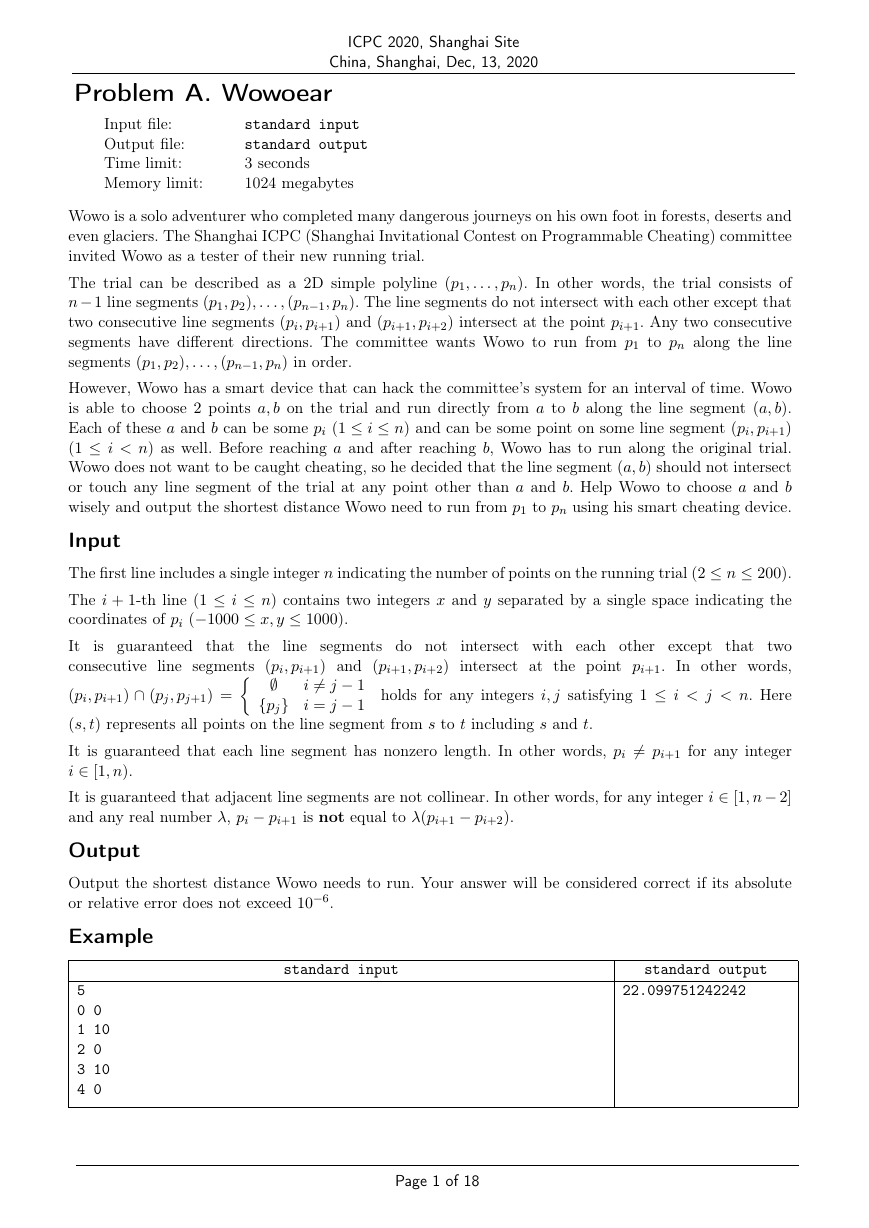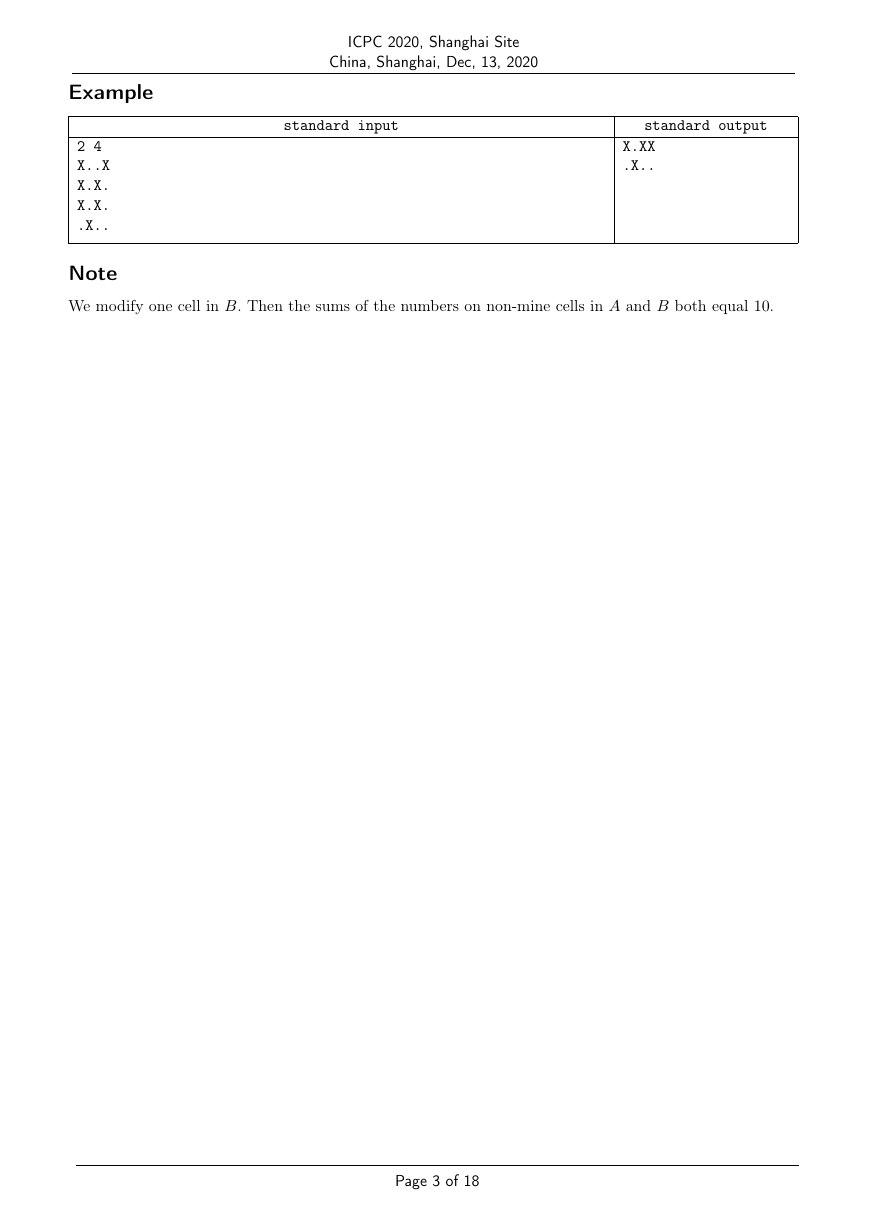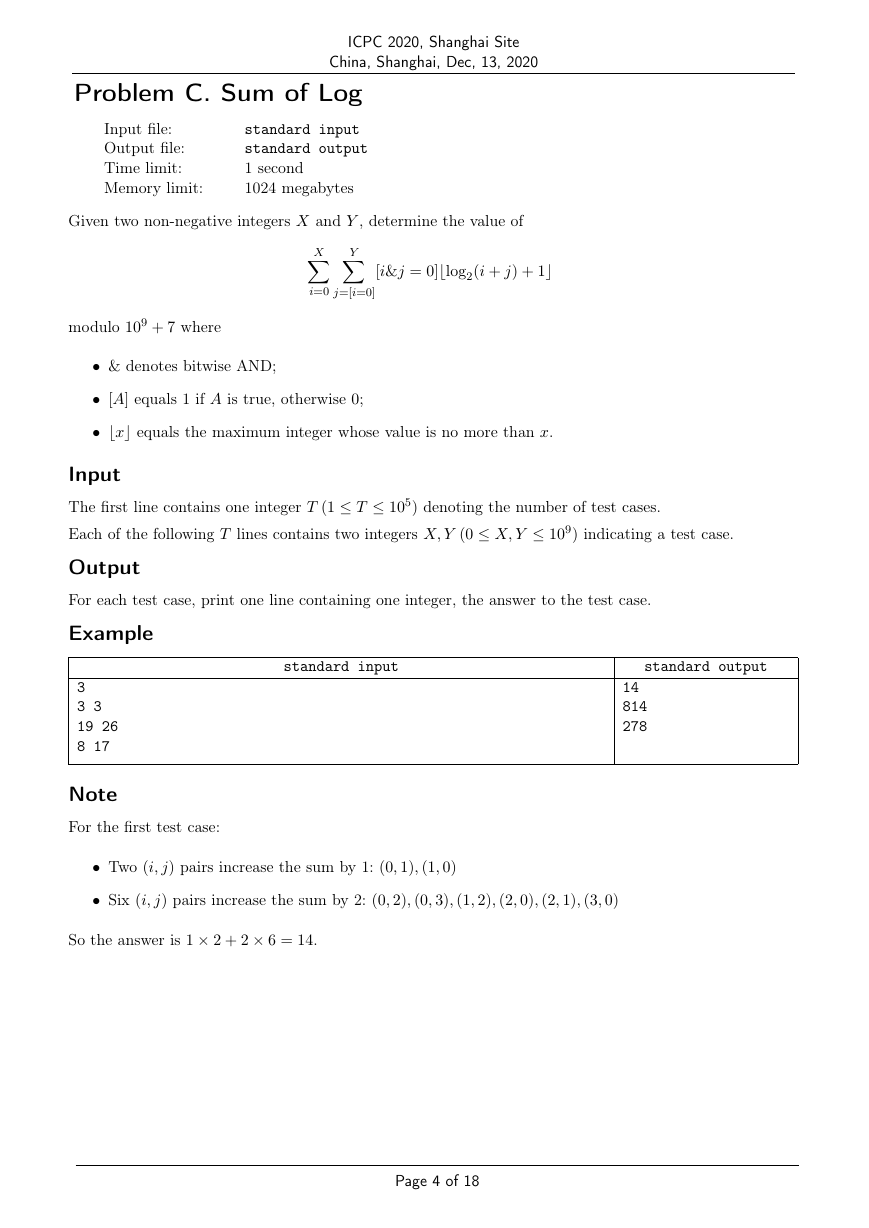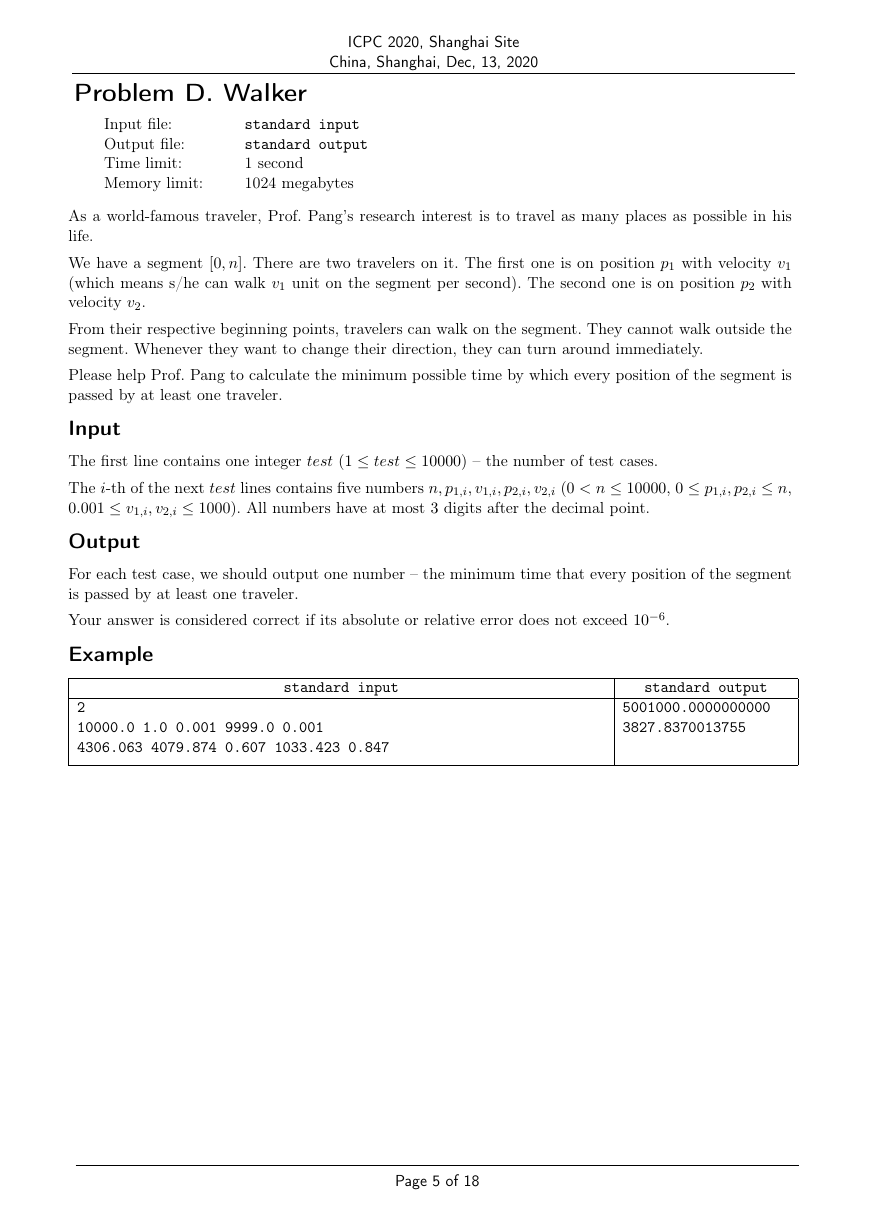�
ICPC 2020, Shanghai Site
China, Shanghai, Dec, 13, 2020
Problem A. Wowoear
Input file:
Output file:
Time limit:
Memory limit:
standard input
standard output
3 seconds
1024 megabytes
Wowo is a solo adventurer who completed many dangerous journeys on his own foot in forests, deserts and
even glaciers. The Shanghai ICPC (Shanghai Invitational Contest on Programmable Cheating) committee
invited Wowo as a tester of their new running trial.
The trial can be described as a 2D simple polyline (p1, . . . , pn). In other words, the trial consists of
n− 1 line segments (p1, p2), . . . , (pn−1, pn). The line segments do not intersect with each other except that
two consecutive line segments (pi, pi+1) and (pi+1, pi+2) intersect at the point pi+1. Any two consecutive
segments have different directions. The committee wants Wowo to run from p1 to pn along the line
segments (p1, p2), . . . , (pn−1, pn) in order.
However, Wowo has a smart device that can hack the committee’s system for an interval of time. Wowo
is able to choose 2 points a, b on the trial and run directly from a to b along the line segment (a, b).
Each of these a and b can be some pi (1 ≤ i ≤ n) and can be some point on some line segment (pi, pi+1)
(1 ≤ i < n) as well. Before reaching a and after reaching b, Wowo has to run along the original trial.
Wowo does not want to be caught cheating, so he decided that the line segment (a, b) should not intersect
or touch any line segment of the trial at any point other than a and b. Help Wowo to choose a and b
wisely and output the shortest distance Wowo need to run from p1 to pn using his smart cheating device.
Input
The first line includes a single integer n indicating the number of points on the running trial (2 ≤ n ≤ 200).
The i + 1-th line (1 ≤ i ≤ n) contains two integers x and y separated by a single space indicating the
coordinates of pi (−1000 ≤ x, y ≤ 1000).
It
two
consecutive line segments (pi, pi+1) and (pi+1, pi+2) intersect at the point pi+1. In other words,
holds for any integers i, j satisfying 1 ≤ i < j < n. Here
(pi, pi+1) ∩ (pj, pj+1) =
(s, t) represents all points on the line segment from s to t including s and t.
It is guaranteed that each line segment has nonzero length. In other words, pi = pi+1 for any integer
i ∈ [1, n).
It is guaranteed that adjacent line segments are not collinear. In other words, for any integer i ∈ [1, n− 2]
and any real number λ, pi − pi+1 is not equal to λ(pi+1 − pi+2).
Output
Output the shortest distance Wowo needs to run. Your answer will be considered correct if its absolute
or relative error does not exceed 10−6.
Example
i = j − 1
{pj} i = j − 1
intersect with each other except
∅
is guaranteed that
the line segments do not
that
standard input
standard output
22.099751242242
5
0 0
1 10
2 0
3 10
4 0
Page 1 of 18
�
ICPC 2020, Shanghai Site
China, Shanghai, Dec, 13, 2020
Problem B. Mine Sweeper II
Input file:
Output file:
Time limit:
Memory limit:
standard input
standard output
1 second
1024 megabytes
A mine-sweeper map X can be expressed as an n × m grid. Each cell of the grid is either a mine cell
or a non-mine cell. A mine cell has no number on it. Each non-mine cell has a number representing the
number of mine cells around it. (A cell is around another cell if they share at least one common point.
Thus, every cell that is not on the boundary has 8 cells around it.) The following is a 16×30 mine-sweeper
map where a flagged cell denotes a mine cell and a blank cell denotes a non-mine cell with number 0.
Given two mine-sweeper maps A, B of size n × m, you should modify at most nm
(i.e. the largest
2
2 ) cells in B (from a non-mine cell to a mine cell or vice
nonnegative integer that is less than or equal to nm
versa) such that the sum of numbers in the non-mine cells in A and the sum of numbers in the non-mine
cells in B are the same. (If a map has no non-mine cell, the sum is considered as 0.)
If multiple solutions exist, print any of them. If no solution exists, print “-1” in one line.
Input
The first line contains two integers n, m (1 ≤ n, m ≤ 1000), denoting the size of given mine-sweeper maps.
The i-th line of the following n lines contains a length-m string consisting of “.” and “X” denoting the i-th
row of the mine-sweeper map A. A “.” denotes for a non-mine cell and an “X” denotes for a mine cell.
The i-th line of the following n lines contains a length-m string consisting of “.” and “X” denoting the i-th
row of the mine-sweeper map B. A “.” denotes for a non-mine cell and an “X” denotes for a mine cell.
Output
If no solution exists, print “-1” in one line.
Otherwise, print n lines denoting the modified mine-sweeper map B. The i-th line should contain a
length-m string consisting of “.” and “X” denoting the i-th row of the modified map B. A “.” denotes for
a non-mine cell and an “X” denotes for a mine cell.
Please notice that you need not print the numbers on non-mine cells since these numbers can be determined
by the output mine-sweeper map.
Page 2 of 18
�
ICPC 2020, Shanghai Site
China, Shanghai, Dec, 13, 2020
standard input
standard output
X.XX
.X..
Example
2 4
X..X
X.X.
X.X.
.X..
Note
We modify one cell in B. Then the sums of the numbers on non-mine cells in A and B both equal 10.
Page 3 of 18
�
ICPC 2020, Shanghai Site
China, Shanghai, Dec, 13, 2020
Problem C. Sum of Log
standard input
standard output
1 second
1024 megabytes
Input file:
Output file:
Time limit:
Memory limit:
Given two non-negative integers X and Y , determine the value of
X
Y
[i&j = 0]log2(i + j) + 1
modulo 109 + 7 where
i=0
j=[i=0]
• & denotes bitwise AND;
• [A] equals 1 if A is true, otherwise 0;
• x equals the maximum integer whose value is no more than x.
Input
The first line contains one integer T (1 ≤ T ≤ 105) denoting the number of test cases.
Each of the following T lines contains two integers X, Y (0 ≤ X, Y ≤ 109) indicating a test case.
Output
For each test case, print one line containing one integer, the answer to the test case.
Example
standard input
standard output
3
3 3
19 26
8 17
Note
For the first test case:
14
814
278
• Two (i, j) pairs increase the sum by 1: (0, 1), (1, 0)
• Six (i, j) pairs increase the sum by 2: (0, 2), (0, 3), (1, 2), (2, 0), (2, 1), (3, 0)
So the answer is 1 × 2 + 2 × 6 = 14.
Page 4 of 18
�
ICPC 2020, Shanghai Site
China, Shanghai, Dec, 13, 2020
Problem D. Walker
Input file:
Output file:
Time limit:
Memory limit:
standard input
standard output
1 second
1024 megabytes
As a world-famous traveler, Prof. Pang’s research interest is to travel as many places as possible in his
life.
We have a segment [0, n]. There are two travelers on it. The first one is on position p1 with velocity v1
(which means s/he can walk v1 unit on the segment per second). The second one is on position p2 with
velocity v2.
From their respective beginning points, travelers can walk on the segment. They cannot walk outside the
segment. Whenever they want to change their direction, they can turn around immediately.
Please help Prof. Pang to calculate the minimum possible time by which every position of the segment is
passed by at least one traveler.
Input
The first line contains one integer test (1 ≤ test ≤ 10000) – the number of test cases.
The i-th of the next test lines contains five numbers n, p1,i, v1,i, p2,i, v2,i (0 < n ≤ 10000, 0 ≤ p1,i, p2,i ≤ n,
0.001 ≤ v1,i, v2,i ≤ 1000). All numbers have at most 3 digits after the decimal point.
Output
For each test case, we should output one number – the minimum time that every position of the segment
is passed by at least one traveler.
Your answer is considered correct if its absolute or relative error does not exceed 10−6.
Example
standard input
2
10000.0 1.0 0.001 9999.0 0.001
4306.063 4079.874 0.607 1033.423 0.847
standard output
5001000.0000000000
3827.8370013755
Page 5 of 18
�
Problem E. The Journey of Geor Autumn
ICPC 2020, Shanghai Site
China, Shanghai, Dec, 13, 2020
Input file:
Output file:
Time limit:
Memory limit:
standard input
standard output
1 second
1024 megabytes
Once upon a time, there was a witch named Geor Autumn, who set off on a journey across the world.
Along the way, she would meet all kinds of people, from a country full of ICPC competitors to a horse
in love with dotabut with each meeting, Geor would become a small part of their story, and her own
world would get a little bit bigger.
Geor just arrived at the state of Shu where people love poems. A poem is a permutation (a1, . . . , an) of
[n]. ((a1, . . . , an) is a permutation of [n] means that each ai is an integer in [1, n] and that a1, . . . , an are
distinct.) One poem is good if for all integer i satisfying i > k and i ≤ n, ai > min(ai−k, . . . , ai−1). Here
min(ai−k, . . . , ai−1) denotes the minimum value among ai−k, . . . , ai−1.
Help Geor calculate how many good poems there are, given n and k. To avoid huge numbers, output the
answer modulo 998244353.
Input
The first line contains two integers n and k separated by a single space (1 ≤ n ≤ 107, 1 ≤ k ≤ 107).
Output
Output only one integer in one linethe number of good poems modulo 998244353.
Examples
standard input
standard output
1 1
2 3
3 2
4 2
1
2
4
10
Page 6 of 18
�
















 2023年江西萍乡中考道德与法治真题及答案.doc
2023年江西萍乡中考道德与法治真题及答案.doc 2012年重庆南川中考生物真题及答案.doc
2012年重庆南川中考生物真题及答案.doc 2013年江西师范大学地理学综合及文艺理论基础考研真题.doc
2013年江西师范大学地理学综合及文艺理论基础考研真题.doc 2020年四川甘孜小升初语文真题及答案I卷.doc
2020年四川甘孜小升初语文真题及答案I卷.doc 2020年注册岩土工程师专业基础考试真题及答案.doc
2020年注册岩土工程师专业基础考试真题及答案.doc 2023-2024学年福建省厦门市九年级上学期数学月考试题及答案.doc
2023-2024学年福建省厦门市九年级上学期数学月考试题及答案.doc 2021-2022学年辽宁省沈阳市大东区九年级上学期语文期末试题及答案.doc
2021-2022学年辽宁省沈阳市大东区九年级上学期语文期末试题及答案.doc 2022-2023学年北京东城区初三第一学期物理期末试卷及答案.doc
2022-2023学年北京东城区初三第一学期物理期末试卷及答案.doc 2018上半年江西教师资格初中地理学科知识与教学能力真题及答案.doc
2018上半年江西教师资格初中地理学科知识与教学能力真题及答案.doc 2012年河北国家公务员申论考试真题及答案-省级.doc
2012年河北国家公务员申论考试真题及答案-省级.doc 2020-2021学年江苏省扬州市江都区邵樊片九年级上学期数学第一次质量检测试题及答案.doc
2020-2021学年江苏省扬州市江都区邵樊片九年级上学期数学第一次质量检测试题及答案.doc 2022下半年黑龙江教师资格证中学综合素质真题及答案.doc
2022下半年黑龙江教师资格证中学综合素质真题及答案.doc